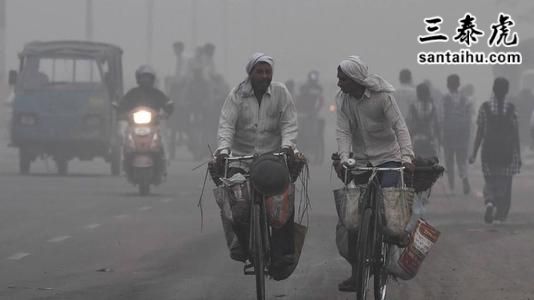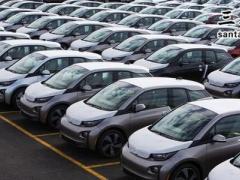为什么印度污染比中国严重?全球前20大污染城市中,印度独占13席
Why is India more polluted than China? Thirteen of the 20 most polluted cities in the world are Indi
Why is India more polluted than China? Thirteen of the 20 most polluted cities in the world are Indian.
为什么印度污染比中国严重?全球前20大污染城市中,印度独占13席。
QUORA网站读者评论:
Balaji Viswanathan
Growing countries get really polluted until they become rich enough to clean up what they created. Think of Dickensian London or US during the Gilded age. It gets really dark before it gets bright again. Being the fastest growing country and the poorest of major economies, it is no wonder that India is the most polluted too.
India is thrice as densely populated as China and it is at a stage where it growing fast enough to add a lot of pollution, but still not rich enough to build solutions fast.
Bad news 1: Coal. India and China are massively adding coal [India's size is a third of China's, but adding equal amount of coal power generation].
发展中国家在变得足够富裕之前,会受到严重的污染。想想狄更斯时代的伦敦或镀金时代的美国吧。这就是黎明前的黑暗。作为发展最快的国家和最贫穷的主要经济体,印度的污染最为严重也就不足为奇了。
印度的人口密度是中国的三倍,目前的发展速度足以造成大量污染,但仍不够富足,无法立即制定解决方案。
坏消息1:煤炭。印度和中国的煤炭消耗量大规模增加(印度的规模是中国的三分之一,但增加的煤炭发电量与中国相当)。
Good news 1: Solar. India plans to multiply its solar generation by 2000% in 5 years. The last few years, India is massively investing in solar power and now the cost of solar is below that of coal. India's big move into solar is already paying off and No takers, Coal India cancels expensive auction
It will take a few years for the solar plans to be completely dominate the Indian power scene and remove coal for the most part.
好消息1:太阳能。印度计划在5年内将太阳能发电量增加2000%。过去几年,印度大举投资太阳能,现在太阳能的成本低于煤炭。印度大举进军太阳能行业已经取得了成效,但无人问津,印度煤炭公司取消了拍卖。
太阳能计划要完全主导印度的电力行业,并大规模淘汰煤炭,还需要几年时间。
Bad news 2: Biomass. Nearly 67% of India burns biomass such as cowdung and wood as their fuel. They are too poor to afford cleaner fuels. Imagine 750 million people burning things. No wonder Indian air has gone so polluted.
坏消息2:生物质。近67%的印度人燃烧牛粪和木材等生物质作为燃料。他们太穷了,买不起更清洁的燃料。想象一下7.5亿人燃烧东西的景象。也难怪印度的空气污染会这么严重。
Good news: LPG to all households. In the next 5 years, majority of these biomass burning households will be converted to the much cleaner burning LPG and possibly some to clean electricity.
Kitchen politics – LPG is the key Budget promise for poor women
好消息:所有家庭使用液化石油气。在未来5年,这些燃烧生物质的家庭大部分将改用更清洁的液化石油气,可能还有一些家庭会使用清洁电力。
厨房政治——液化石油气是对贫困妇女最大的预算承诺
Bad news 3: Automobiles. Indian roads have a lot of dirt [tar topping is too narrow] and majority of the city transportation happens through polluting vehicles like autorickshaws and diesel buses. When highly polluting autorickshaws hit the dirt on the side while slowly meandering through a traffic choked road, pollution is a natural result.
坏消息3:汽车。印度的道路上有很多泥土(沥青路面太窄),城市交通大部分依赖于高污染车辆,如嘟嘟车和柴油车。当高污染的嘟嘟车在拥堵的道路上缓慢行驶时,碾过路边的泥土,污染就是自然的结果。
Good news: Metro rail projects are taking off. In another decade, most of India's major cities will run metro rail rather than the polluting vehicles. Rapid transit in India
好消息:地铁项目正在快速发展。再过10年,印度大多数主要城市将开通地铁,取代污染车辆。印度的快速交通。
Bad news 4: Factories. India is rapidly pushing into manufacturing and in its zeal to attract factories, it is not doing enough enforcement on environmental rules. Oil refineries, leather tanneries and other industries with political power continue to pollute at will.
坏消息4:工厂。印度正迅速进军制造业,在引入工厂方面热情高涨,但在环保法规方面执行不力。炼油厂、皮革制革厂等有政治力量的行业继续肆意污染。
China, being richer, is already way ahead of India when it comes to using cleaner fuels for domestic cooking, has built rail projects everywhere and slowly started enforcing the pollution standards. India will have to go through the hump.
中国更为富裕,在使用更清洁的燃料做饭方面已经远远领先于印度,各地都修建了铁路项目,并逐步开始执行污染排放标准。印度也不得不渡过难关。
Siddhartha Banerjee, Middle class man in Kolkata
Mostly India is a alluvial except the mountains of the north, plateaus of central and hills of the south/west. Alluvial soil is very light compared other soil type and forms the top layer. This is not only prone to erosion but causes significant dust by suspension. Even if an area has a considerable green cover, in absence of rain/ground moisture for a few days the soil is prone to be air borne. This is again amplified by the fact that we have most of the rains concentrated during the moonsoon, which means most of year around the conditions are favourable for dust. Even in the remote interiors if the country where there are no industries, you will find considerable amount of dust in the air.
除了北部的山脉、中部的高原和南部/西部的丘陵,印度大部分地区都是冲积层。冲积土与其他土质类型相比很轻,形成了地表层。这不仅容易侵蚀,还会引起尘埃悬浮。即使一个地区有充足的绿色植被,若几天不下雨/地面水分流失了,土壤就容易通过空气传播。这又被一个事实放大了,那就是我们的大部分降雨都集中在季风季节,这意味着一年中大部分时间都有利于尘埃的形成。即使在没有工业的偏远内陆地区,你也会发现空气中有相当多的灰尘。
1.The climate is mostly humid including the plains, mountains and most of the plateaus compared to many of the other countries. Even in october you can have 60-70% relative humidity in Delhi and 90+ RH in Kolkata. This basically compounds the smog factor as micro droplets settle over the suspended dust and creates a layer of haze. This increases dramatically during winters when dew point is reached more often, and natural fog combines with these suspended particles.
2.Now coming to the human impact. Political will is slowly recognizing this devil in disguise and have started to act. However environmental regulation is hardly enforced, due to the common perception that let industries grow, we will tackle the mess later. This applies for water and sound pollution too.
3.Vehicular emission is unchecked and not enforced. The latest cars we use are Euro 4 standard, while most of the older vehicles hardly have any pollution certificates. The government vehicles specially are the most polluting ones, which needs immediate action.
1.这里的气候包括平原、山脉和大部分高原地区,与其他许多国家相比大多都较为潮湿。即使在10月份,德里的相对湿度也能达到60-70%,加尔各答的相对湿度也能达到90+ RH。微滴落在悬浮的尘埃上并形成一层雾霾,这基本上就是雾霾形成的多重原因。冬季露水增多,自然雾气会与这些悬浮颗粒结合在一起,这种情况会急剧增加。
2.现在来谈谈人类的影响。政治意愿慢慢识破这个魔鬼的伪装,开始采取行动。然而,由于人们普遍认为应该先发展工业,以后再处理环境问题,环保法规很难执行。水污染和噪音污染也是如此。
3.车辆排放不受限制,也没有强制执行。我们使用的最新车型是欧4标准,而大多数老款车几乎没有任何污染证明。尤其是政府汽车,是污染最严重的汽车,需要立即处理。
4.Unregulated public works activities like relaying asphalt of road repairs are done with archaic technologies where tar is melted and poured over stone chips. This creates huge levels of emissions and again due to high relative humidity and dust, doesn't disperse immediately. Going back to the earlier points - in places like Mumbai where there is a considerable sea breeze there are more chances of this being dispersed, where as in places like the gangetic belt it is not so.
5.Factories are usually built with their chimneys around 100 feet tall (atleast the old pre modern ones) so that they can get the fair breeze (there is a technical term for this which I am unable to recall), for dispersal of pollutants. This is no more applicable as in cities there are more buildings around the same height.
6.India is probably one of the largest consumers of coal for generation of electricity. When these thermal power plants were constructed they were significantly outside the city limits and close to a good supply chain (river, highways, railways etc). As the population burgeoned the cities grew and gradually have engulfed the power plants.
4.不受管制的市政工程,如道路维修时重铺沥青,还在采用陈旧的技术,熔化沥青,倒在石片上。这会产生大量的排放,而且由于相对湿度和灰尘较高,不会立即消散。回到之前提到的几点——在孟买这样的地方有海风,容易消散,而恒河一带就不行了。
5.工厂的烟囱通常有100英尺高(至少近现代的老烟囱是这样的),这样工厂就有风(我记不清了,这还有个技术术语)来排放污染物。这在城市中就不再适用了,因为附近的建筑物高度都差不多。
6.印度可能是发电用煤的最大消费国之一。当初建设这些火电厂时,并不在城市范围之内,而是临近供应链完善之地(河流、公路、铁路等)。随着人口的迅速增长,城市不断扩大,并逐渐吞没了发电厂。
7.Most of the poor dont have access to LPG and use cow dungs, twigs and barks to light their ovens. This is extremely polluting, which needs to be phased out.
8.There is a huge problem of slash and burn in the country side, and as I highlighted earlier there is a less distinctive geographical boundary between urban and rural these pollutants affect millions now.
9.Restaurants still use tandoor and coal based ovens. Even hawkers in the metros continue to do so unchecked. This is a big problem in Kolkata, where every hawker is now a tandoor master chef, with open pit coal ovens in front of offices. Not only pollution, Kolkata is also know for its fire.
7.大多数穷人没有液化石油气,只能用牛粪、树枝和树皮来生火。这是非常污染缓解的,需要逐步淘汰。
8.农村地区存在着严重的毁林烧荒问题,正如我前面强调的那样,城市和农村之间的地理界限不那么明显,这些污染物现在影响着数百万人。
9.餐馆仍然使用筒状泥炉和煤基烤炉。即使是地铁里的小贩也在肆无忌惮地叫卖。这在加尔各答是个大问题,那里的每一个小贩现在都是筒状泥炉的大厨,办公室前就有露天煤炉。不仅污染严重,加尔各答的火灾也是出了名的多。
Most of reasoning are my observations, and some might not be fairly accurate. If there are environmental experts in this forum, please help me rectify as applicable
大部分推理都是我的观察,有些可能不太准确。如果论坛里有环境专家,请纠正我的说法。
Ram Singh, Indian, Patriot, proud, and all of the above. Loose environmental laws and actions taken against defaulters.
When the pollution emitted by factories is clearly visible, i don’t really think why a strict action cannot be taken immediately.
Instead of closing down the industy, they are given nice affectionate notice letters. Then lawsuits and counter lawsuits are filed, which leads long hearings. then again the lawsuits are fought in courts for months, and guess what by the time its in the courts, 100s of animals have been killed, 100s of trees have died, and 100s of humans have begun to fall ill.
All we now need is strict action against defaulters who pollute the environment. Either you clean up the mess, or empty your factories.
当工厂毫不掩饰地排放污染时,我真的不知道为什么不能立即采取严格的措施。
工业区没有被关停,他们反而收到了亲切的通知信。然后开始提起诉讼和反诉讼,导致了长时间的听证会。然后诉讼案在法庭上掐了几个月,你猜法庭审理期间发生了什么,几百只动物被杀,几百棵树死亡,几百个人开始生病。
我们现在需要的是对污染环境的人采取严厉行动。要么你收拾好残局,要么清空你的工厂。
- Lack of our will
The 3 major pollution sources in the world are Industries, Transportation, Buildings
Most indians are unwilling to
1.Install pollution control technology to their industries, because it would mean spending more.
2.Regularly getting vehicles checked and serviced because it would mean spending more.
3.Green buildings are not designed and implemented, because, any guesses?
The psyche of today’s Indian people is that to earn money and neglect nature of it comes in the way
Some might give a reason like developing countries tend to go through the same phase. i don’t think that’s an excuse.
- 缺乏意志
世界上三大污染源是工业、交通、建筑
大多数印度人不愿意
1.为他们的工厂安装污染监控技术,因为这意味着要花更多的钱。
2.定期检查和维修车辆,因为这意味着要花更多的钱。
3.没人设计绿色建筑,也没人执行,因为...还用猜吗?
如今印度人的心理是要赚钱,却忽视了赚钱的本质
有些人可能会辩解,比如发展中国家都要经历同样一个阶段。我不认为那是理由。
Vibhinn Gautam, Avid learner of China and its' history.
The reason India is heavily polluted is because...
a.) Indian celebrations, including usage with cow dung, means that methane is released to the air. Methane is more powerful than carbon dioxide.
b.) India's just rapidly advancing. India, just 10 years ago was a lot different than it was now.
c.) When there are huge amounts of people in a small amount of land, pollution is bound to be higher. Such as for USA, CHINA, and INDIA. Notice, Canada pollutes a lot of carbon dioxide. Yet, it remains as one of the least polluted
印度污染严重的原因是……
- a) 印度的庆祝活动会使用牛粪,意味着甲烷被释放到空气中。甲烷的威力比二氧化碳大。
b)印度正在快速发展。区区10年前的印度就和现在发生了很大的变化。
c)当大量的人聚集在一小块土地上时,污染一定会严重起来。比如美国、中国和印度。注意,加拿大污染了很多二氧化碳。但它仍然是污染最少的城市之一。
d) India is a developing country. Developing countries just think of this: "We should probably focus on economy and stuff, rather than climate change. We'll deal with that later." Developed countries are different, like "Ok, we've got a strong economy and a good ranking on the Global Peace Index, and stuff. Now climate is something we've to tackle." And no offence, but developing countries pollute ever slightly more, because they don't have clean opportunities.
Hopefully you enjoy this post!!
d)印度是一个发展中国家。发展中国家可以这样想:“我们或许应该集中精力发展经济和其他方面,而不是气候变化。我们等日后再来处理那个问题。”发达国家就不一样了,他们想的是诸如“好,我们现在的经济强大了,在全球和平指数上的排名也不错。现在我们必须解决气候的问题了。”无意冒犯,但发展中国家的污染比以往任何时候都多,因为她们还没有清洁的机会。
希望你喜欢这篇文章!!
Saka Venkata Satya Prasad, works at Private Clinic Skin
Owning a car was a luxury 30 years ago.
India moved on two wheelers and diesel trains.
Fuel which costed a few rupees is now more costlier.
Transport was a thing of the past and now rapid transport is the new norm.
Economy depends on demand and supply.
Create demand to improve supply.
30年前,拥有汽车是一件奢侈品。
印度开始有了汽车和柴油火车。
原本只需要几卢比的燃料现在变得更贵了。
交通运输已经是过去的事了,现在快速运输已经成了新标准。
经济依赖于需求和供给。
创造需求来改善供应。
In comes marketing with thier own mind setting rules and psychological warfare to create a demand of urgency and manufactures items that don't last long.
Result is that consumption increases but quality downgrades.
So what should be done.
One cannot change the way something is being manufactured and hence the thinking changes.
So a dynamic world looks at change that is permanent and investment constant.
随之而来的是市场营销,他们用自己的思维制定规则和心理战争创造紧迫的需求,制造不太耐用的商品。
结果是,消费增加了,但商品质量却下降了。
那么我们应该做些什么。
人不能改变某样东西的生产方式,因此思维发生了改变。
因此,一个动态的世界认为变化是永恒不变的,投资一直在持续。
To bring about a balance of living and healthy living one pays to live healthy life.
Those who have money pollute those who don't aspire for non polluted world.
Literally the people around the world move on the roads polluting and live in air conditioned houses polluting.
So get along invent a life and plant more trees for they don’t cost much live long and provides oxygen.
为了在生活和健康生活之间取得平衡,人们必须为健康生活付出代价。
有钱的人污染那些并不渴求世界不被污染的人。
实际上全世界的人都在道路上行进着污染着,住在开着空调的房子里污染着。
所以,多种树吧,种树养树不需要太费力气,还能制造氧气。
Say no to smoking.
Encourage cycles.
Eat more vegetables and have a roof top kitchen garden. They will keep you healthy.
Small points but if many follow will cut down pollution by atleast .001 %
拒绝吸烟。
鼓励回收再利用。
多吃蔬菜,开辟一个屋顶花园。它们会让你健健康康的。
这些都是小事,但如果很多人照做,污染能减少至少0.01%。
Arun Kumar, Assistant Manager at Punjab National Bank (2016-present)
If you are asking with respect to Indian cities then, North India has more industrial belts and also most of the mineral and natural resources. Hence Usage of mines and Industrial plants in Large scale is the reason for it. Also these plants are made way back in 1960-1980s era and are not upto the current standards of Environment. Further, Environment and its wellbeing has not been priority for India.
One more reason can be that in India, Population is not evenly spread out and hence, a Densely populated area will be exploited by the citizens. So the Metro cities will large amount of Population and no capacity to handle them. Prime example is Delhi and Mumbai.
Next is the Communities are based near rivers and hence magnify the problem above. India which has chronic problem of inability to provide waters to the citizen compels the citizen to use the rivers and water source for their and hence add to it.
India in general relies on Thermal and other forms of energy which adds to the pollution index very much.
如果你问的与印度城市有关,那么印度北部有更多的工业带,还有大部分的矿产和自然资源。因此,矿山和工业厂房的大规模使用是其原因。此外,这些工厂的建设可以追溯到1960-1980年代,并不符合当前的环境标准。此外,环境及其福祉并不是印度优先考虑的问题。
另一个原因可能是印度的人口分布并不均匀,因此,人口密集的地区会被充分开发。所以大城市会聚集大量的人口,超过其承载能力。最好的例子是德里和孟买。
其次,这些社区都建在河流附近,从而放大了上述问题。印度长期以来都无法为公民提供充足的水资源,迫使公民使用河流和水源,使得问题愈发严重。
印度总体上依赖热能和其他能源,大大增加了污染指数。
Rajneesh Tyagi, Software Tester.
More People = Use of More Vehicles = More Pollution.
More People = More homes required =More Land required = More Construction = More Pollution.
More People = Need more roads connectivity = Need to Cut more Trees = More Pollution.
Limited Place of Employement = More state people at one place = More Transportation = More Pollution.
更多的人=车辆使用就更多=更多的污染。
更多的人=更多的房子=更多的土地=更多的建筑=更多的污染。
更多的人=需要更多的道路连接=需要砍伐更多的树木=更多的污染。
有限的就业地点=更多的人口挤在一个地方=更多的交通工具=更多的污染。
Small Roads with Cheap quality = More dust = More Pollution.
No use of traffic rules = More traffic jam = More Pollution.
More People = More use of products =More waste material =Less Govt. Support = More Pollution.
More People = More Water Usage = low ground water level =More Pollution.
More People = Cut more Trees = Eat & Kill Animals = Affect the Biological life cycle =Affect balance of Earth (Nature).
More People = Burden on the earth = Invitation to “the end of the world”.
质量低劣的小路=更多的灰尘=更多的污染。
不遵守交通规则=更多的交通堵塞=更多的污染。
更多的人=更多的商品消耗=更多的废料=更少的政府支持=更多的污染。
更多的人=用水量越多=地下水位越低=污染越严重。
更多的人=砍伐更多的树木=宰杀食用动物=影响生物的生命周期=影响地球(自然)的平衡。
更多的人=地球的负担=导致“世界末日”。
Krishna Khot, Engineer, Introvert, Reader, Learner, Explorer
I think the Indians are more responsible for this pollution.
We Indians have the habit of throwing useless and waste things wherever there is open space without thinking about pollution.
If you consider this attitude then same is true for industries. Industries don't care much about following pollution control measures. They just want to minimize cost of dumping wastes.
The attitude of Indians is the main problem for pollution...
Would like to tell an example. Recently govt launched some new railway coaches which are clean, comfortable and good looking. But after the few days of usage the coach was in very bad condition. The seat was broken, the face washing sink was filled with dirty water and coach was dirty.
This shows our attitude towards pollution.
我认为印度人应对这种污染负更大的责任。
我们印度人有一种习惯,只要是空地就往里乱扔垃圾,不考虑会不会污染环境。
工业生产也一样。工厂并不在意要遵循污染控制措施。他们只想把垃圾处理的成本降到最低。
印度人的态度就是造成污染的主要原因……
我想举个例子。最近,政府推出了一些新的火车车厢,干净、舒适、美观。但投入使用才没几天,车厢的状况就糟糕透了。座位破损,洗脸槽里积满脏水,车厢也肮脏不堪。
这足以说明我们对污染的态度。
Ragavan Srinivasan, works at Tata Consultancy Services
In addition to all the other points which our fellow quorans added i think governing policy in our country is one indirect yet prime factor. Not all people have their self interest in protecting our environment, sometimes we need a strong governing body to create fear among people to do the right thing. I feel democracy in our country doesnt do this efficiently for now compared with communist China. I hope this mentality of people will change so that they dont need force to control them to do the right thing
除了我们的Quora同胞网友的观点之外,我想补充一下,我认为我国的管理政策是一个虽间接但主要的因素。并不是所有的人都有动力来保护我们的环境,有时我们需要一个强大的管理机构让国民怀着敬畏心做正确的事。我们国家的制度目前还不能有效地做到这一点。我希望人们的这种心态能改变一下,这样就不需要动用武力来管束他们去做正确的事。
Jay Erickson
World's second populous country is India. So cities are highly polluted with population this is the main reason for India's pollution.
- Household sewage usually taken to fall in rivers, lakes this leads to water get polluted and raised bad smell and useless for drinking purpose.
- The use of plastics are increased day by day and after use it throws or burn that causes soil pollution and air pollution.
- Household chemical detergents using for washing clothes, cleaning bathrooms etc are not completely oxidized, they produce alcohol and organic acid which pollute water and harms living organisms.
- Smoke released from industrial plants, fuel and engines causes air pollution.
印度是世界排名第二的人口大国。所以城市因为人口太多而高度污染,这是印度污染的主要成因。
- 生活污水排入河流、湖泊,导致水体污染,产生难闻的气味,无法饮用。
- 塑料的使用日益增加,使用后丢弃或燃烧,造成了土壤污染和空气污染。
- 家用洗衣、洗浴等化学洗涤剂未完全氧化,产生了酒精和有机酸,污染水源,危害生物。
- 工厂、燃料和发动机排放的烟雾造成了空气污染。
外文链接:https://www.quora.com/Why-is-India-more-polluted-than-China-Thirteen-of-the-20-most-polluted-cities-in-the-world-are-Indian
版权声明
我们致力于传递世界各地老百姓最真实、最直接、最详尽的对中国的看法
【版权与免责声明】如发现内容存在版权问题,烦请提供相关信息发邮件,
我们将及时沟通与处理。本站内容除非来源注明五毛网,否则均为网友转载,涉及言论、版权与本站无关。
本文仅代表作者观点,不代表本站立场。
本文来自网络,如有侵权及时联系本网站。
阅读:
-
1
चाइना में रेडी और ठेले Local shops in china || L...
- 2
- 3
- 4
- 5
- 6
- 7
- 8
- 9
- 10
-
1
चाइना में रेडी और ठेले Local shops in china || L...
- 2
- 3
- 4
- 5
- 6
- 7
- 8
- 9
- 10











